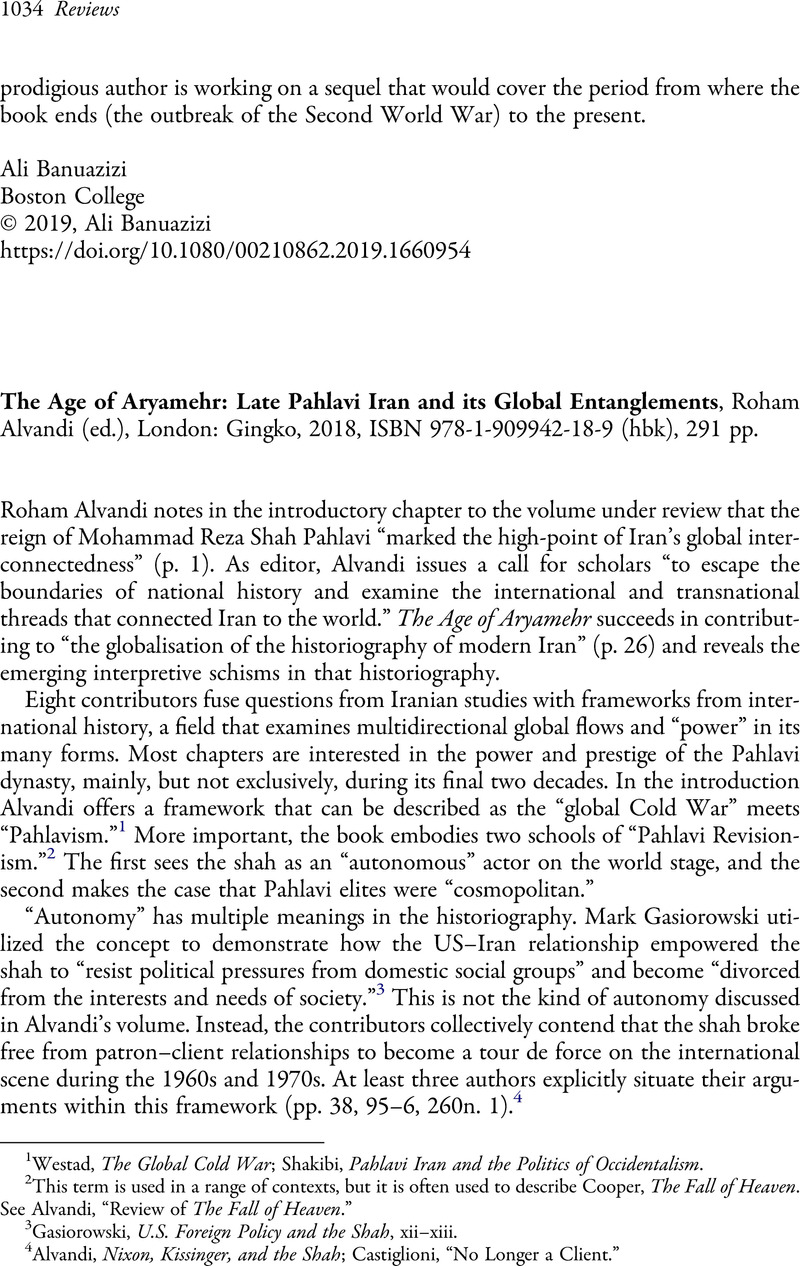No CrossRef data available.
Article contents
The Age of Aryamehr: Late Pahlavi Iran and its Global Entanglements, Alvandi Roham, (ed.), London: Gingko, 2018, ISBN 978-1-909942-18-9 (hbk), 291 pp.
Published online by Cambridge University Press: 01 January 2022
Abstract
An abstract is not available for this content so a preview has been provided. Please use the Get access link above for information on how to access this content.

- Type
- Reviews
- Information
- Iranian Studies , Volume 52 , Issue 5-6: Special Section: Saʿdi at Large , November 2019 , pp. 1034 - 1037
- Copyright
- Copyright © Matthew Shannon 2019
References
Alvandi, Roham. Nixon, Kissinger, and the Shah: The United States and Iran in the Cold War. New York: Oxford University Press, 2014.CrossRefGoogle Scholar
Alvandi, Roham. “Review of The Fall of Heaven, by Andrew Scott Cooper.” Middle East Journal 71, no. 1 (2017): 155–6.Google Scholar
Castiglioni, Claudia. “No Longer a Client, Not Yet a Partner: The US–Iranian Alliance in the Johnson Years.” Cold War History 15, no. 4 (2015): 491–509.CrossRefGoogle Scholar
Cooper, Andrew Scott. The Fall of Heaven: The Pahlavis and the Final Days of Imperial Iran. New York: Holt, 2016.Google Scholar
Dabashi, Hamid. Iran Without Borders: Towards a Critique of the Postcolonial Nation. New York: Verso, 2016.Google Scholar
Dorman, William, and Farhang, Mansour. The U.S. Press and Iran: Foreign Policy and the Journalism of Deference. Berkeley: University of California Press, 1987.CrossRefGoogle Scholar
Gasiorowski, Mark. U.S. Foreign Policy and the Shah: Building a Client State in Iran. Ithaca, NY: Cornell University Press, 1991.CrossRefGoogle Scholar
Jahanbegloo, Ramin. “Iranian Intellectuals and Cosmopolitan Citizenship.” In Iranian Identity and Cosmopolitanism: Spheres of Belonging, ed. Stone, Lucian, 17–33. New York: Bloomsbury, 2014.Google Scholar
Marwick, Arthur. The Sixties: Cultural Revolution in Britain, France, Italy, and the United States, c. 1958–c. 1974. New York: Oxford University Press, 1998.Google Scholar
Milani, Abbas. The Persian Sphinx: Amir Abbas Hoveyda and the Riddle of the Iranian Revolution. Washington, DC: Mage, 2004.Google Scholar
Milani, Abbas. Eminent Persians: The Men and Women Who Made Modern Iran, 1941–1979. Syracuse, NY: Syracuse University Press, 2008.Google Scholar
Niall, Ferguson, Maier, Charles, Manela, Erez, and Sargent, Daniel, eds. The Shock of the Global: The 1970s in Perspective. Cambridge, MA: The Belknap Press of Harvard University Press, 2010.Google Scholar
Shakibi, Zhand. Pahlavi Iran and the Politics of Occidentalism: The Shah and the Rastakhiz Party. London: I.B. Tauris, forthcoming 2019.Google Scholar
Westad, Odd Arne. The Global Cold War: Third World Interventions and the Making of Our Times. New York: Cambridge University Press, 2005.CrossRefGoogle Scholar




